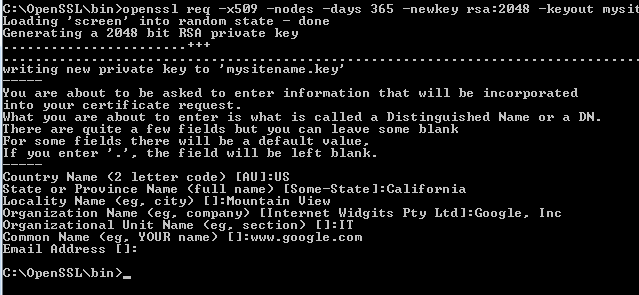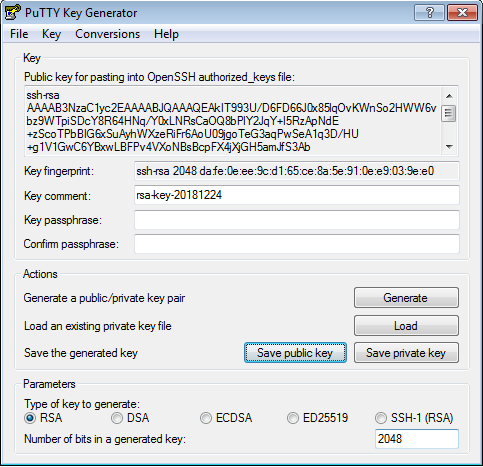Generate Public Private Key Openssl
Mar 31, 2018 In this post I will demonstrate how to regenerate a public key from the corresponding private key that you still have. Generate public key and store into a file. It is a simple one liner command to generate a public key from a private key, so lets say our private key is named ‘user@myserver.key’ and we want to generate the public key. Apr 15, 2020 The ability to create, manage, and use public and private key pairs with KMS enables you to perform digital signing operations using RSA and Elliptic Curve (ECC) keys. You can also perform public key encryption or decryption operations using RSA keys. For example, you can use ECC or RSA private keys to generate digital signatures. Mar 03, 2020 This page explains how to generate public/private key pairs using OpenSSL command-line tools. Device authentication. Cloud IoT Core uses public key (or asymmetric) authentication: The device uses a private key to sign a JSON Web Token (JWT). The token is passed to Cloud IoT Core as proof of the device's identity. Reasons for importing keys include wanting to make a backup of a private key (generated keys are non-exportable, for security reasons), or if the private key is provided by an external source. This document will guide you through using the OpenSSL command line tool to generate a key pair which you can then import into a YubiKey.
-->To sign an assembly with a strong name, you must have a public/private key pair. This public and private cryptographic key pair is used during compilation to create a strong-named assembly. You can create a key pair using the Strong Name tool (Sn.exe). Key pair files usually have an .snk extension.
Note
In Visual Studio, the C# and Visual Basic project property pages include a Signing tab that enables you to select existing key files or to generate new key files without using Sn.exe. In Visual C++, you can specify the location of an existing key file in the Advanced property page in the Linker section of the Configuration Properties section of the Property Pages window. The use of the AssemblyKeyFileAttribute attribute to identify key file pairs was made obsolete beginning with Visual Studio 2005.
Create a key pair
To create a key pair, at a command prompt, type the following command:
sn –k <file name>
In this command, file name is the name of the output file containing the key pair.
The following example creates a key pair called sgKey.snk.
If you intend to delay sign an assembly and you control the whole key pair (which is unlikely outside test scenarios), you can use the following commands to generate a key pair and then extract the public key from it into a separate file. First, create the key pair:
Generate Public Private Key Openssl Free
Next, extract the public key from the key pair and copy it to a separate file:
Once you create the key pair, you must put the file where the strong name signing tools can find it.
When signing an assembly with a strong name, the Assembly Linker (Al.exe) looks for the key file relative to the current directory and to the output directory. When using command-line compilers, you can simply copy the key to the current directory containing your code modules.
If you are using an earlier version of Visual Studio that does not have a Signing tab in the project properties, the recommended key file location is the project directory with the file attribute specified as follows:
See also

- This module allows one to (re)generate OpenSSL public keys from their private keys.
- Keys are generated in PEM or OpenSSH format.
- The module can use the cryptography Python library, or the pyOpenSSL Python library. By default, it tries to detect which one is available. This can be overridden with the select_crypto_backend option. When format is
OpenSSH, thecryptographybackend has to be used. Please note that the PyOpenSSL backend was deprecated in Ansible 2.9 and will be removed in Ansible 2.13.”
The below requirements are needed on the host that executes this module.
- Either cryptography >= 1.2.3 (older versions might work as well)
- Or pyOpenSSL >= 16.0.0
- Needs cryptography >= 1.4 if format is
OpenSSH
| Parameter | Choices/Defaults | Comments |
|---|---|---|
| attributes string | The attributes the resulting file or directory should have. To get supported flags look at the man page for chattr on the target system. This string should contain the attributes in the same order as the one displayed by lsattr. The = operator is assumed as default, otherwise + or - operators need to be included in the string. | |
| backup added in 2.8 |
| Create a backup file including a timestamp so you can get the original public key back if you overwrote it with a different one by accident. |
| force boolean |
| Should the key be regenerated even it it already exists. |
| format string |
| |
| group | Name of the group that should own the file/directory, as would be fed to chown. | |
| mode string | The permissions the resulting file or directory should have. For those used to /usr/bin/chmod remember that modes are actually octal numbers. You must either add a leading zero so that Ansible's YAML parser knows it is an octal number (like 0644 or 01777) or quote it (like '644' or '1777') so Ansible receives a string and can do its own conversion from string into number.Giving Ansible a number without following one of these rules will end up with a decimal number which will have unexpected results. As of Ansible 1.8, the mode may be specified as a symbolic mode (for example, u+rwx or u=rw,g=r,o=r).As of Ansible 2.6, the mode may also be the special string preserve.When set to preserve the file will be given the same permissions as the source file. | |
| owner string | Name of the user that should own the file/directory, as would be fed to chown. | |
| path path / required | Name of the file in which the generated TLS/SSL public key will be written. | |
| privatekey_passphrase string | The passphrase for the private key. | |
| privatekey_path path | Path to the TLS/SSL private key from which to generate the public key. | |
| select_crypto_backend added in 2.9 |
| Determines which crypto backend to use. The default choice is auto, which tries to use cryptography if available, and falls back to pyopenssl.If set to pyopenssl, will try to use the pyOpenSSL library.If set to cryptography, will try to use the cryptography library. |
| selevel string | Default: | The level part of the SELinux file context. This is the MLS/MCS attribute, sometimes known as the range.When set to _default, it will use the level portion of the policy if available. |
| serole string | When set to _default, it will use the role portion of the policy if available. | |
| setype string | When set to _default, it will use the type portion of the policy if available. | |
| seuser string | By default it uses the system policy, where applicable.When set to _default, it will use the user portion of the policy if available. | |
| state string |
| Whether the public key should exist or not, taking action if the state is different from what is stated. |
| unsafe_writes boolean |
| Influence when to use atomic operation to prevent data corruption or inconsistent reads from the target file. By default this module uses atomic operations to prevent data corruption or inconsistent reads from the target files, but sometimes systems are configured or just broken in ways that prevent this. One example is docker mounted files, which cannot be updated atomically from inside the container and can only be written in an unsafe manner. This option allows Ansible to fall back to unsafe methods of updating files when atomic operations fail (however, it doesn't force Ansible to perform unsafe writes). IMPORTANT! Unsafe writes are subject to race conditions and can lead to data corruption. |

See also
- openssl_certificate – Generate and/or check OpenSSL certificates
- The official documentation on the openssl_certificate module.
- openssl_csr – Generate OpenSSL Certificate Signing Request (CSR)
- The official documentation on the openssl_csr module.
- openssl_dhparam – Generate OpenSSL Diffie-Hellman Parameters
- The official documentation on the openssl_dhparam module.
- openssl_pkcs12 – Generate OpenSSL PKCS#12 archive
- The official documentation on the openssl_pkcs12 module.
- openssl_privatekey – Generate OpenSSL private keys
- The official documentation on the openssl_privatekey module.
Office 365 product key generator online. Common return values are documented here, the following are the fields unique to this module:
Openssl Generate Public Private Key Pair And Csr
| Key | Returned | Description |
|---|---|---|
| backup_file string | changed and if backup is yes | Sample: |
| filename | changed or success | Path to the generated TLS/SSL public key file. /etc/ssl/public/ansible.com.pem |
| fingerprint dictionary | changed or success | The fingerprint of the public key. Fingerprint will be generated for each hashlib.algorithms available. Sample: {'md5': '84:75:71:72:8d:04:b5:6c:4d:37:6d:66:83:f5:4c:29', 'sha1': '51:cc:7c:68:5d:eb:41:43:88:7e:1a:ae:c7:f8:24:72:ee:71:f6:10', 'sha224': 'b1:19:a6:6c:14:ac:33:1d:ed:18:50:d3:06:5c:b2:32:91:f1:f1:52:8c:cb:d5:75:e9:f5:9b:46', 'sha256': '41:ab:c7:cb:d5:5f:30:60:46:99:ac:d4:00:70:cf:a1:76:4f:24:5d:10:24:57:5d:51:6e:09:97:df:2f:de:c7', 'sha384': '85:39:50:4e:de:d9:19:33:40:70:ae:10:ab:59:24:19:51:c3:a2:e4:0b:1c:b1:6e:dd:b3:0c:d9:9e:6a:46:af:da:18:f8:ef:ae:2e:c0:9a:75:2c:9b:b3:0f:3a:5f:3d', 'sha512': 'fd:ed:5e:39:48:5f:9f:fe:7f:25:06:3f:79:08:cd:ee:a5:e7:b3:3d:13:82:87:1f:84:e1:f5:c7:28:77:53:94:86:56:38:69:f0:d9:35:22:01:1e:a6:60:.:0f:9b'} |
| format string | changed or success | Sample: |
| privatekey | changed or success | Path to the TLS/SSL private key the public key was generated from. /etc/ssl/private/ansible.com.pem |
- This module is not guaranteed to have a backwards compatible interface. [preview]
- This module is maintained by the Ansible Community. [community]
Authors¶
- Yanis Guenane (@Spredzy)
- Felix Fontein (@felixfontein)
Hint
Adobe photoshop cs6 serial key generator free download. https://evercp236.weebly.com/blog/psp-video-9-download-mac. If you notice any issues in this documentation, you can edit this document to improve it.